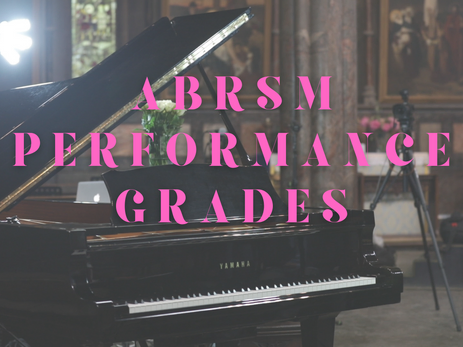Piano Lessons
ABRSM Performance Grades
Year 2020 may have possibly been the worst year for pretty much everyone in the world, but one good thing that came out was the opportunity to take the ABRSM performance exam online due to Coronavirus in the UK, rather than the regular practical grade. This may have temporarily allowed musicians to still proceed with their musical progress during lockdowns and this pandemic. However, with more people warming to the idea, should it be a permanent way to examine students… Let’s go through this famous option: ABRSM Performance Grades, and the main ABRSM piano exams currently available.
What Is The ABRSM Performance Grades?
How Does It Differ From The Practical Exam as Piano Grades Exams?
The ABRSM performance garde exam is a remotely assessed grade meaning that once you feel you are prepared, all you need to do is record the performance following the guidelines from ABRSM and then submit the recording for the examiner to mark. With the ability to submit your exams every month, there are no significant deadlines and no unnerving performance pressures, and this gives you complete control of your exam to show off your capabilities.
Despite the two grades being the same level of musically demanding, these ABRSM performance grades online have different requirements. As we know, the performance grade consists of three pieces from the ABRSM syllabus alongside sight-reading, scales and aural exams.
However, the Performance exam requires four pieces from the syllabus and nothing else. So whether you feel you are more confident with scales, sight-reading and aural or whether you just like playing your pieces, there are now exams to suit everyone’s strengths and desires.
What Would I Have To Do In The Video Submission?
To take the ABRSM exams in the UK, the video submission should be high quality and at such an angle where the examiner can clearly see both the performer and the instrument. You will need to show your previously filled-in programme form, including your songs information, the composer’s name, syllabus list number, syllabus year, the timing of breaks, and the instrument used in performance.
You will also have to show (for five seconds) your ‘own choice piece’, making sure the examiner can see the title, opening clef, key, time signature, tempo marking and first few lines of music.
You will then have to announce your name, exam subject, grade, piece title, composer name and list information for each piece before you start playing and in the order, you wish you play them.
The video must have a continuous flow with no editing, stopping or starting. The idea is to make a full performance of the four pieces selected.
However, between pieces, it is a good idea to take a few moments to gather yourself and your thoughts before starting so you can get into the mood of the piece i.e dynamics, tempo etc.
For children who are doing grades 1-3, try to count to ten in your head with your hands off the piano before starting a new piece to ensure there is enough space between the repertoire.
It would also be a good idea to thank the examiners for their time at either the beginning or end of your recording so that you are acknowledging their presence even if they are not physically in the room with you. This can be done either with a bow (as you would at the end of a concert) or in a spoken manner, either one (or both) would be acceptable. As well as this, as it is a performance exam, dressing appropriately as if you were playing a real live concert will be a great addition to your video. Dressing in black, smart clothing will really show the examiner that you are aware of performance etiquette and have knowledge of one other aspect aside from just the piece you are about to play. Dressing appropriately will help you stand out and may even give you a few more marks so it doesn’t hurt to scout out your favourite dress/trousers. As well as prepare the room to make it look nice and tidy.
Here we share a video in which ABRSM explains how to set-up and record your performance grades 1-5:
Guide on how to set up for a Grade 6-8 piano performance grade:
Do I Lose Out On Anything Doing The ABRSM Performance Grades?
No, Both exams are marked in the same way and are weighted the same.
Whether you choose to do the performance or practical exams, your grade will still be just as meaningful for both. It is meant to remain a fair system that just allows musicians to choose and explore their preferences.
What Are The Examiners Really Looking For If They Can’t Mark On Technicalities Such As Scales?
When continuously playing four pieces, the examiners will be looking at the musician’s focus and stamina alongside the regular musical communication that they need to achieve the demand that the level of the pieces requires.
How Do I Make My Decision?
Overall, the performance exam is all about which you would prefer.
If you enjoy the setting of going to the exam hall and playing for the examiner, or find that your strongest skill sets lie within scales, sight-reading and aural exams then there is probably no need to change your path. Despite this, if you suffer from performance anxiety and can play four pieces without getting tired, then the performance exam may be a better option.
It’s not necessarily about the words you get from the certificate after, or which exams your classmates entered for. It’s about how your learning can impact you in the best possible way, as musical growth should be your number one priority.
Learn all about ABRSM Performance grades with WKMT London. Book your trial now and become officially ABRSM Trained.
#abrsm #abrsmperformance #abrsmperformancegrades #abrsmperformancediploma

